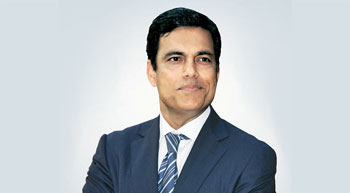Jaigarh Port, situated along the west coast of Maharashtra, is a roaring tiger! Sajjan Jindal, Chairman and Managing Director, JSW Group, speaks at length about the group’s partnership with the government and the company’s various investment plans in an exclusive interview with RAHUL KAMAT.
Jaigarh Port seems to be breaking all barriers and touching new heights. How futuristic is this port?
We have designed this port for the future, keeping in mind the volumes of inbound and outbound trade (that) is likely to happen. Our plan is to bring a Valemax-size vessel which can carry 400 thousand tonnes of iron.
So to your question about how futuristic is this port, I would like to mention that Jaigarh Port has commissioned new mechanised berths to serve coastal cargo for Capesize vessels and transform it to a transshipment hub. Furthermore, JSW Infrastructure is developing Jaigarh Port to handle LNG, LPG, liquid cargo and container berths for diversified and specialised cargo-handling operations.
The port has taken initiatives in roads and rail infrastructure upgradation..
Yes, along with this, we will be developing a 42-km road to create a linkage between the port and Nivali on national highway NH 66 (earlier NH 17). This two-lane road was widened to a four-lane highway in 2014, and has now been further upgraded into a six-lane highway.
In conjunction with the Indian Railways, we have laid the foundation stone for a 34-km |Jaigarh-Digni Railway Line on the Konkan Railway network, providing additional connectivity options. On completion, this railway line will assist in improving the current connectivity situation wherein the nearest railway link is at Ratnagiri – a distance of 55 km on the Konkan Railway network.
This is a very interesting railway project because it is in public- private partnership (PPP) mode and three partners – the Government of Maharashtra, Konkan Railway and JSW Infrastructure – will come together to develop this project. Interestingly, along the 55-km route, around 18 km will pass through various tunnels. Our total equity in the rail line project is around Rs 192 crore.
How will this (Jaigad-Digni) rail line improve the port’s performance?
This is a very specific and ‘futuristic’ question! However, with West to East connectivity -Jaigarh to Digni and Chiplun and Karad – our port will get connected to the hinterland of Pune, Solapur, Kolhapur and Naded, right up to Hyderabad. Hence, with these rail lines up and running in (the) stipulated timeframe, our port will become an important logistics destination in Maharashtra after JNPT and Mumbai Port.
The port was inaugurated in 2007; what plans have you envisaged to increase the port’s capacity from the current level?
Since this port received its first ship in 2009, it has witnessed a growth of 30 per cent year-on-year. At present, we have a capacity to handle 40 million tonnes (MT) of bulk cargo. But by 2020, we have plans to increase the capacity from 15 million tonnes per annum (mtpa) to 80 mtpa and further, 150 mtpa (by 2035).
As an infrastructure company, apart from Jaigarah, we have operational ports in Goa and Dharamtar, where put together, we have handled 34 mtpa, this year. So considering the capex plans for all three ports together, we will be increasing our capacity to 200 mtpa by 2020. Until now, we have invested around Rs 2,000 crore in expansion of this port and are planning to invest Rs 2,000 crore more in it. Besides that, we have planned a capex of Rs 7,000 crore in various ports over the next three years. Meanwhile, the company is developing iron ore and coal export terminals at Paradip Port in Odisha, in a PPP (purchasing power parity) model, with a capacity of 48 MT per annum.
The Indian government has plans to setup large refineries; one of them is in the same vicinity where Jaigarh Port is located. How will it facilitate the growth of the port?
There is a plan of the Government of India to set up a large refinery plant near Jaigarh Port. The 60 mtpa capacity refinery will be jointly developed by Indian Oil Corporation, Hindustan Petroleum Corporation and Bharat Petroleum Corporation in Maharashtra in a phased manner.
The Phase-1 capacity will be 40 mtpa together with an aromatic complex, naphtha cracker unit and a polymer complex. This will cost Rs 1.2-1.5 lakh crore and will come up in 5-6 years from the date of land acquisition. The mega complex will require 12,000-15,000 acres and two-three sites along the coast of Maharashtra are being explored. The second phase, involving a 20 mtpa refinery, will cost Rs 50,000-60,000 crore.
Now, let’s cut to Jaigarh. Our advantage is since the refinery will be in the same location, we are pitching this port as a captive port to the refinery. So by us becoming a captive port to refineries, the government needs to put in additional investments into a greenfield port.
Can you give us more details on the LNG re-gasification facility? What would be the capacity, and will it be expanded, and what is your investment?
The project has been developed by Hiranandani Energy. The company has already commenced the construction work of a jetty for the floating storage and re-gasification unit (FSRU) project. The total capacity of the facility will be around 3 mtpa initially, which will witness an upgradation of 5 mtpa and 8 mpta in later stages of development. The project is likely to be completed in 2018.
In addition, the project scope also includes construction of a gas pipeline of around 60 km from Jaigarh Port to the existing natural gas pipeline network at Dabhol. The total cost of the project will be around Rs 4,000 crore.
Our port will manage the construction of the jetty civil works and has appointed L&T Infrastructure Engineering, for jetty design.
– RAHUL KAMAT



Leave a Reply
You must be logged in to post a comment.